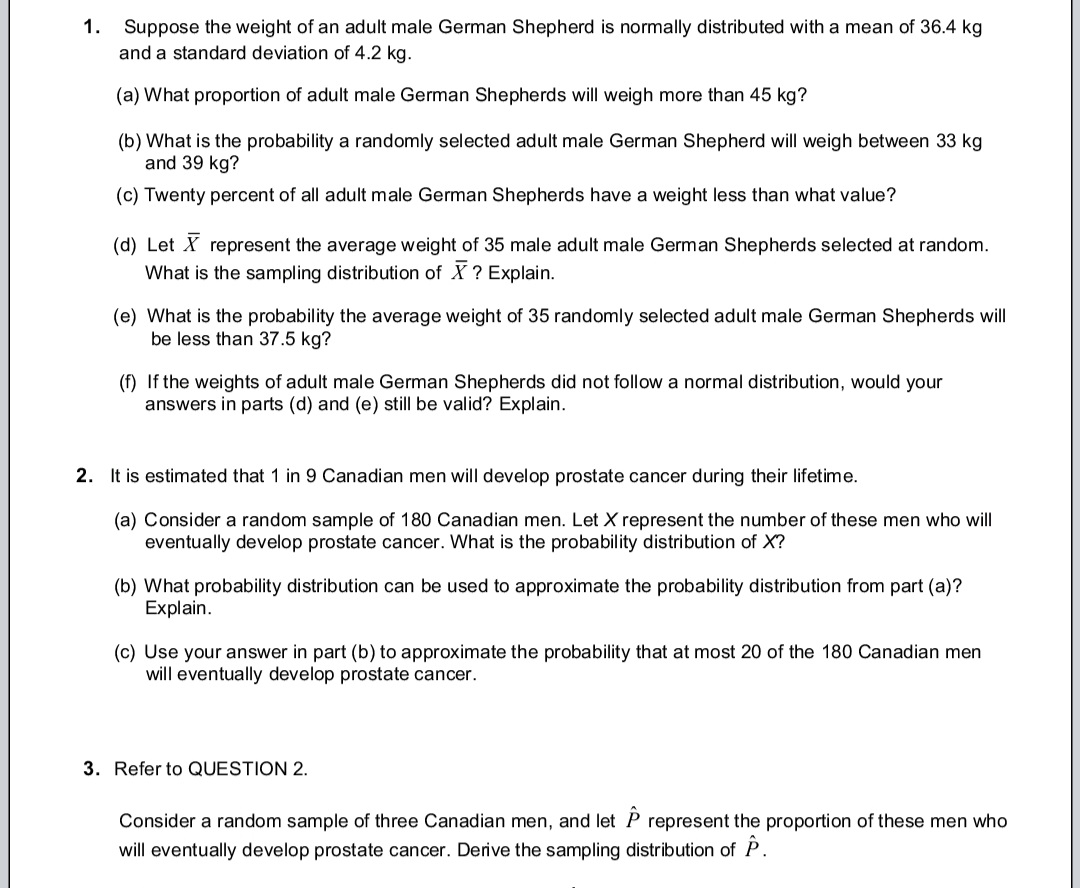1. Suppose the weight of an adult male German Shepherd is normally distributed with a mean of 36.4 kg and a standard deviation of 4.2 kg. (a) What proportion of adult male German Shepherds will weigh more than 45 kg? (b) What is the probability a randomly selected adult male German Shepherd will weigh between 33 kg and 39 kg? (c) Twenty percent of all adult male German Shepherds have a weight less than what value? (d) Let X represent the average weight of 35 male adult male German Shepherds selected at random. What is the sampling distribution of X ? Explain. (e) What is the probability the average weight of 35 randomly selected adult male German Shepherds will be less than 37.5 kg? (f) If the weights of adult male German Shepherds did not follow a normal distribution, would your answers in parts (d) and (e) still be valid? Explain.
1. Suppose the weight of an adult male German Shepherd is normally distributed with a mean of 36.4 kg and a standard deviation of 4.2 kg. (a) What proportion of adult male German Shepherds will weigh more than 45 kg? (b) What is the probability a randomly selected adult male German Shepherd will weigh between 33 kg and 39 kg? (c) Twenty percent of all adult male German Shepherds have a weight less than what value? (d) Let X represent the average weight of 35 male adult male German Shepherds selected at random. What is the sampling distribution of X ? Explain. (e) What is the probability the average weight of 35 randomly selected adult male German Shepherds will be less than 37.5 kg? (f) If the weights of adult male German Shepherds did not follow a normal distribution, would your answers in parts (d) and (e) still be valid? Explain.
MATLAB: An Introduction with Applications
6th Edition
ISBN:9781119256830
Author:Amos Gilat
Publisher:Amos Gilat
Chapter1: Starting With Matlab
Section: Chapter Questions
Problem 1P
Related questions
Question

Transcribed Image Text:1.
Suppose the weight of an adult male German Shepherd is normally distributed with a mean of 36.4 kg
and a standard deviation of 4.2 kg.
(a) What proportion of adult male German Shepherds will weigh more than 45 kg?
(b) What is the probability a randomly selected adult male German Shepherd will weigh between 33 kg
and 39 kg?
(c) Twenty percent of all adult male German Shepherds have a weight less than what value?
(d) Let X represent the average weight of 35 male adult male German Shepherds selected at random.
What is the sampling distribution of X ? Explain.
(e) What is the probability the average weight of 35 randomly selected adult male German Shepherds will
be less than 37.5 kg?
(f) If the weights of adult male German Shepherds did not follow a normal distribution, would your
answers in parts (d) and (e) still be valid? Explain.
2. It is estimated that 1 in 9 Canadian men will develop prostate cancer during their lifetime.
(a) Consider a random sample of 180 Canadian men. Let X represent the number of these men who will
eventually develop prostate cancer. What is the probability distribution of X?
(b) What probability distribution can be used to approximate the probability distribution from part (a)?
Explain.
(c) Use your answer in part (b) to approximate the probability that at most 20 of the 180 Canadian men
will eventually develop prostate cancer.
3. Refer to QUESTION 2.
Consider a random sample of three Canadian men, and let P represent the proportion of these men who
will eventually develop prostate cancer. Derive the sampling distribution of P.
Expert Solution
This question has been solved!
Explore an expertly crafted, step-by-step solution for a thorough understanding of key concepts.
This is a popular solution!
Trending now
This is a popular solution!
Step by step
Solved in 4 steps with 3 images

Recommended textbooks for you

MATLAB: An Introduction with Applications
Statistics
ISBN:
9781119256830
Author:
Amos Gilat
Publisher:
John Wiley & Sons Inc

Probability and Statistics for Engineering and th…
Statistics
ISBN:
9781305251809
Author:
Jay L. Devore
Publisher:
Cengage Learning

Statistics for The Behavioral Sciences (MindTap C…
Statistics
ISBN:
9781305504912
Author:
Frederick J Gravetter, Larry B. Wallnau
Publisher:
Cengage Learning

MATLAB: An Introduction with Applications
Statistics
ISBN:
9781119256830
Author:
Amos Gilat
Publisher:
John Wiley & Sons Inc

Probability and Statistics for Engineering and th…
Statistics
ISBN:
9781305251809
Author:
Jay L. Devore
Publisher:
Cengage Learning

Statistics for The Behavioral Sciences (MindTap C…
Statistics
ISBN:
9781305504912
Author:
Frederick J Gravetter, Larry B. Wallnau
Publisher:
Cengage Learning

Elementary Statistics: Picturing the World (7th E…
Statistics
ISBN:
9780134683416
Author:
Ron Larson, Betsy Farber
Publisher:
PEARSON

The Basic Practice of Statistics
Statistics
ISBN:
9781319042578
Author:
David S. Moore, William I. Notz, Michael A. Fligner
Publisher:
W. H. Freeman

Introduction to the Practice of Statistics
Statistics
ISBN:
9781319013387
Author:
David S. Moore, George P. McCabe, Bruce A. Craig
Publisher:
W. H. Freeman